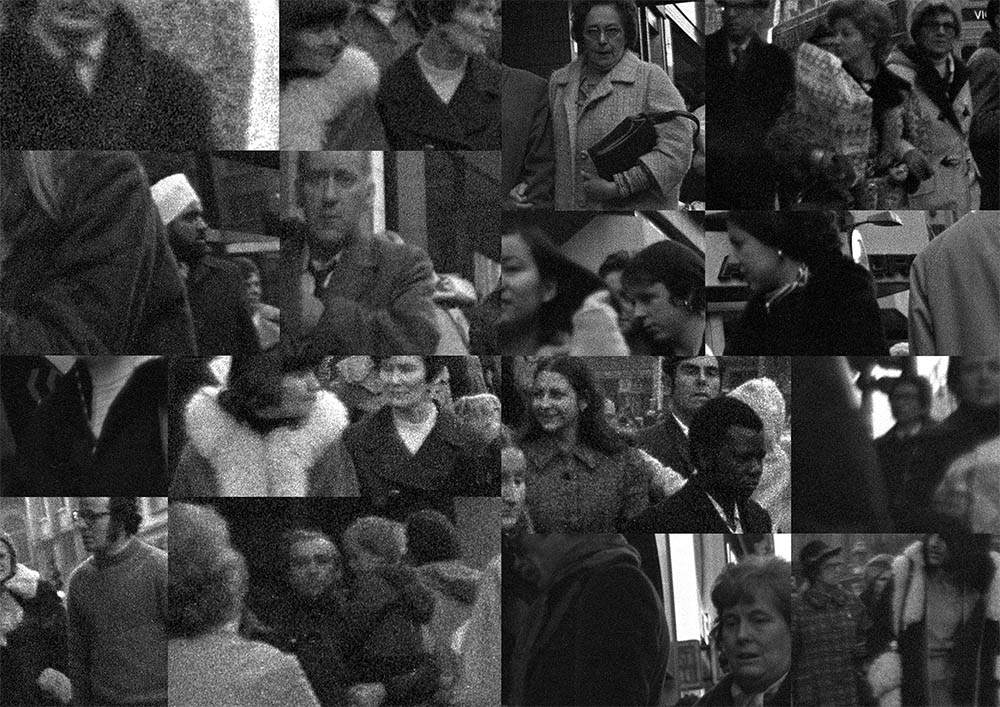
The London River, Oxford Street, December 1973 (detail).
2018.
LdiF : You like these metaphors of the river, of flows and streams...
PFW: I'm not keen on metaphor, and I try not to do anything that is metaphorical. I understand the word as meaning something that is symbolic or represents another, perhaps quite different, thing. Metaphors are expressive and, I think, often make limited cultural assumptions. I think I use analogy, and analogy based on an etymologically correct use of common language. So, if I use the word river it's because in both the dictionary and in everyday usage the word does not just mean a body of moving water but anything that flows, especially in a channel or on a defined path.
LdiF: So, this one is actually called "The London River" and was made quite a long time ago?

The London River, Oxford Street, December 1973 (detail).
2018.
PFW: Yes, the original negatives were made in December 1973. I walked slowly east to west, against the flow, from Tottenham Court Road on the south side of Oxford Street in London, clicking the shutter as I went, without looking through the camera viewfinder, until the film was used up. It was a very dull, dark, afternoon and I slightly underexposed the film, which is why they are so grainy. I suppose part of what they are 'about' is the pleasure of watching ordinary people going about their business, not posing or in any way modifying their behaviour for the camera. A few might look at it but, because the camera is not being held up to my eye, they look at in a way that's completely different to the way they would if someone was doing the "I am taking a photograph of you" pose. It's just a glance, with a significance that reciprocates the slight pressure of the finger on the shutter release, which is just a click but it can capture something that resonates against time, a kind of shared sympathy. Am I making sense?
LdiF: Yes, I like this thing about not posing. The photographs don't seem to impose on the people shown in them anymore than the people impose on the camera. So often when you see portraits, even street photos, it's as if the image is making the person act out some sort of meaning. It's a kind of violation. These don't do that. So, in 1973 you were a young art student, studying painting at Winchester. What fascinates me is how, on a painting course, you started taking photos where you were relinquishing control. One might think you would have been trying to take great photos, like Stieglitz, Bourke White, Richard Avedon or, wasn't Diane Arbus getting noticed around that time?.
PFW: I think she'd just died, so there were a few shows and lots of talk about her.
LdiF: We looked at your boxes of negatives earlier and what I saw from that time were dozens and dozens of whole 36 exposure sheets of 35mm negatives and so many of them appeared to be of totally random subjects, or obsessing on several very slightly different shots of some, usually very mundane, object or view, or these streets scenes, often with nothing much happening in them, sometimes just fragments and often without much attention to the correct focus or exposure and no apparent consideration of composition or design. What was the thought process that brought you to do them? You don't seem to be honing your craft?
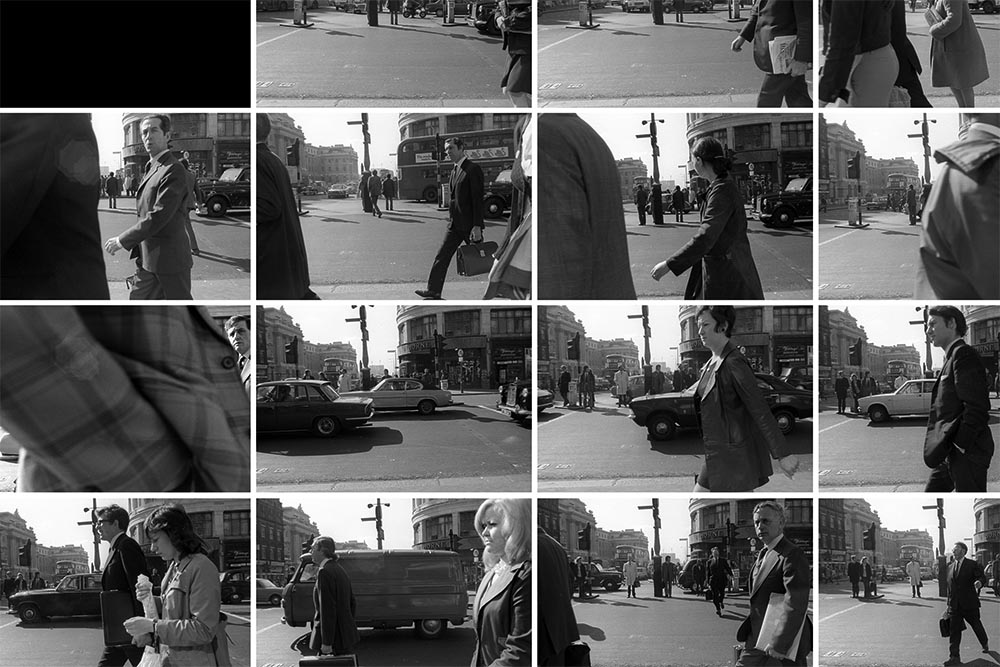
Crossing, Strand, London, May 1974 (detail).
2013.
PFW: I think I was reacting to some of the conservative presumptions I found at art school. There weren't really Fine Art courses at that time, so it was a painting course or nothing. I think I'm right in saying that when I first went to art school, in 1972, there was only one undergraduate course in photography in the UK, Trent Polytechnic in Nottingham I think, and that would, I guess, have been rather utilitarian. From a very young age I'd been interested in photography and I think I saw it as just another, or rather as a very important, art medium. And I knew that most, probably, of the art of what was then "our" century that would last into, and seem important in, the future was photographic or had a big relationship with photography. I soon learnt that nearly 150 years on from its invention it was still the subject of derision in large and powerful sections of the art world. That has changed a lot now but then it was powerful.
When I got to art school I saw that painting, well art generally, could be very competitive and all about ego. At St Martin's and Winchester there were some really heavy duty painters and some much tougher egos than mine. In recent years I've talked a lot to people who were at art school at that time and they almost all, especially women, say what an adversarial place it was. "Not exactly nurturing" is a typical phrase and, with a few important exceptions, that's pretty much how I felt about art school staff and culture in the 1970s. My interest in photography meant I could side-step and, I suppose, be very adversarial in my own way.....
LdiF: But you weren't trying to learn the skills and aesthetics of "art" photography, so you could challenge the painters with great and profound fine photographic prints?
PFW: No, the art that I liked was not overtly 'great' in the way that say, The Night Watch or Guernica or Blue Poles might be considered 'great'. I liked the ducking and diving artists like Duchamp, Hamilton and Warhol.....I could never get on with photographers who try to aggrandise their work with the great tropes, if that's the right word, of art. You can forgive, almost, nineteenth century photographers like P. H. Emerson, but I remember sitting in the library at Winchester reading Edward Weston's Daybooks and becoming increasingly nauseated by his insistence on Art, Art, Art and his own importance as an Artist. There might be a lot of good stuff in Weston's pictures, and I might now not even be able to find what I took such exception to in his writing (and in Ansel Adams and Cartier Bresson et al., although the notions of 'pre-visualising' and the 'decisive moment' spring to mind as being particularly contentious) but then I was a bolshy young art student with a corner of my own to fight.
There was also a photographic fashion at the time called 'social documentary', or 'social realism', which I saw as middle class - which in England, you know, means upper class, or at least affluent, educated, professional - people making careers out of the poor and disadvantaged, just like old Emerson had done. I came from a relatively poor and disadvantaged background, culturally and socially disadvantaged certainly, and I was suspicious of all that crap.
There were some people working in the 70s that I was enthusiastic about. I saw John Hilliard's show at the Lisson Gallery and there was a big article on him in a photography special of Studio International around that time. He kind of took photography apart - both the mechanics and the representational assumptions - and made me think "I can do something different". Also I was very keen on structural film, used to go to screenings at the London Film Makers Co-op to see things like Michael Snow's La Région Centrale which seemed to be getting away from anthropocentrism, or at least the will of the individual, creative, mind.
LdiF: So, on a painting course in the first half of the 1970s you must have been rather isolated?
PFW: Yes, at the end I was told that the painters wanted to give me a third, which is not much better than a fail, and it was only the art history tutor and the head of print making who argued me up to a 2:1. It didn't set me up with confidence to go forward. But that's a long time ago, so let's not dwell....
LdiF: Can you tell me something more about why you started doing these random, although sometimes quite structured or methodical in the way you made or arranged them, but essentially random street photographs?
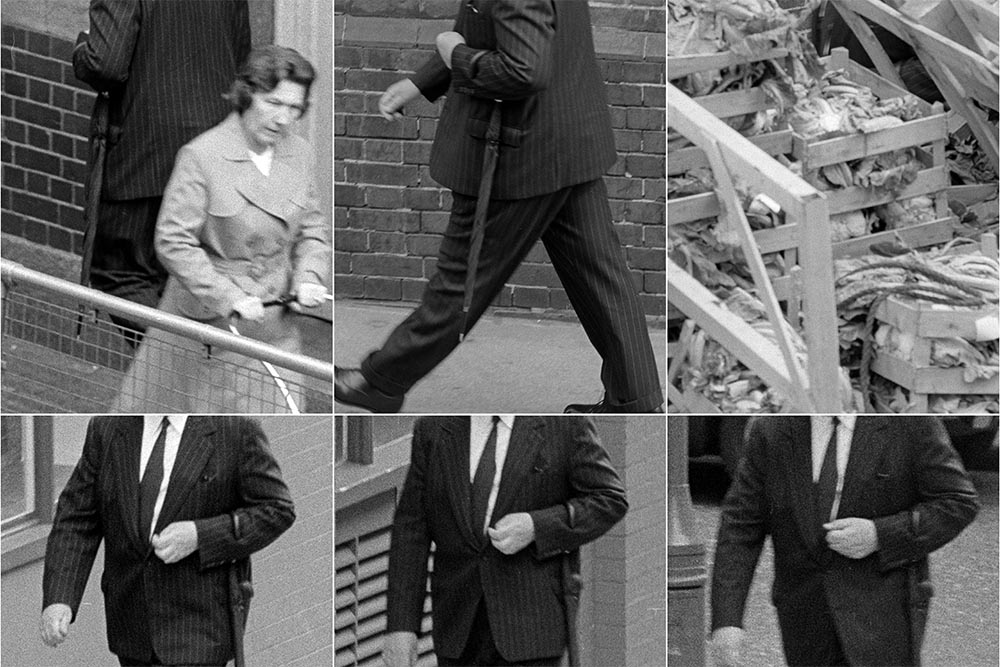
The Crossing: Drury Lane, London, 1974 (detail).
2017.
PFW: OK. I doubted the documentary claims made for photography. I think there's even a case to be made, argued, that photography is not essentially, structurally, a representational medium. I couldn't understand why, if photography was such a great documentary medium its exponents relied on design and composition and pictorial devices that came from painting, and from painting of hundreds of years before the invention of photography. If to document meant to record or to provide evidence, the practices of documentary photographers were analogous to an interviewer taking the subject's words and turning them into poetry, making them scan and rhyme. Does that make sense?
LdiF: Yes, like that picture of the Migrant Mother with all its triangles and lines, like a painting of the Madonna and Child?
PFW: Dorothea Lang, yes it's an O.K. photograph and it was made to do a job, and there's a long story to it. But there is something essentially false about it. Any truth or fact about it has to be a construct, using information that is outside of the picture. It's not as simple as its presentation might imply. For a start, it's posed, the image is a collaboration between sitter and photographer...and it's significance relies on, is conditioned by, intentions that may not be appropriate to the image.
What I was trying to do was to see what would happen if I tried to use the camera, but to not make pictures, in the sense of graphic compositions that derive from the conventions of drawing and painting. So I started to develop a, practice is not the right word - I don't think that word was used much in the 1970s - I started to develop a process of taking photographs without intention. There was always some sort of method, even if it was just to take all 36 pictures on the film as fast as possible. I was careless but attentive: I tried to keep the camera level, not induce camera shake, get the exposure right. I stopped looking through the view finder, used a telephoto lens so it was difficult to guess which part of what was in front of me it was pointing at. But at the moment of pressing the shutter my aim was that all pictorial considerations and apprehensions of meaning were absent.
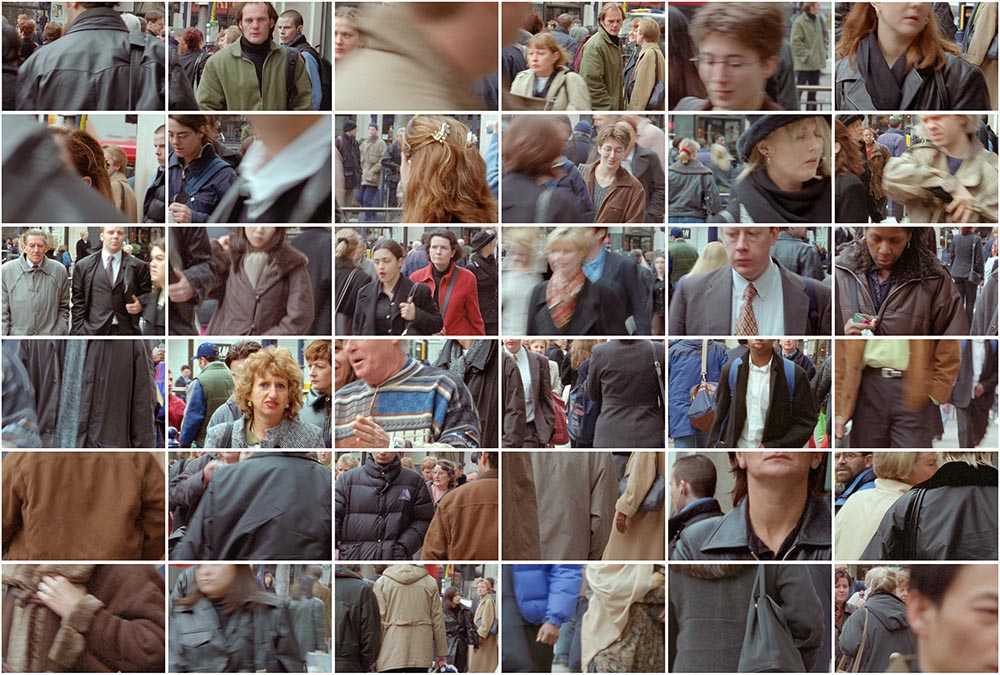
The Wall: Asteroid "Heading for Earth". Regent Street, London. Thursday March 12th 1998.
2016.
LdiF: So, how does this relate to the street photos? I think I can see, but could you expand?
PFW: I could only work with what I had around me. So I got the camera to make its images of the things in front of it, and as it was always with me, or I with it, that was my family home and home town of Ramsgate, and then in later years wherever I've lived, worked or visited, and the streets I've walked through, or traffic islands I've stood on. Linked to this way of working with the camera came the notion of photographing people where neither party - the subject nor, as far as possible, the photographer - was posing.
That's how the street photos came about and I have been going back through the boxes of negatives you looked at earlier to see how I might bring them back to life, and doing a few more, all the time trying not to do the photographer's, or the artist's pose, although that's inescapable, of course.
LdiF: So..'The London River'..'Piccadilly Falls'..'The Wall'?
PFW: I'm still working on them, from just now and from forty whatever years ago. Titles are provisional, everything's provisional with me, still moving. But, the flow of people, through the streets and down the years reminds me of a river; you can drown your self in it, get lost in it, getting across it can be hard, sometimes it's a wall, impenetrable, it can push you aside. It can be clear and limpid or seem so dense and opaque. You can fight against it, or float along with it. Most of all it is constantly flowing. I remember once, around midnight on New Year's Eve in Trafalgar Square the crush and surge of people was so strong that I found I could take my feet off the ground and be carried along, floating in a wave of people, and then it dissipated and I found myself, back on my rather unsteady feet, in the spume at the edge. I tottered down Northumberland Avenue and there was no one there. I was alone, like on an empty beach, the kind I knew in Ramsgate in my youth, in the middle of this great city at the most intense moment of the year.....
LdiF (sings):
Vanti, o cara, il ruscello
di fremer gorgogliando
rotto fra sterpi e sassi
finché poi .....
PFW: Stop. Please! What is that?
LdiF: It's about the sputtering and gurgling stream becoming a flowing silvery thing that ends by embracing the sands of the seashore, meaning estuary, I guess. Handel, you must know it, you like Handel. Aci, Galatea e Polifemo, it's an early work from his time in Italy. I know it because I sang Polifemo back home, at school in Catania when I was a kid...and I remember it because I was in love with the girl who sang Aci, I knew her words better than I did mine. Hey and after all...the Water Music!
PFW: And the Fireworks, another place where I like to float about and see what I can dredge up. Yes I like Handel, but I don't know that.
LdiF: The Cyclops kills Acis and Galatea turns his blood into a river. There might be something there for you...
PFW: You know I'm not that keen on metaphor and mythology. They make for pretty stories and easy meanings but they can be deadly: too much taking them for reality might be the fatal flaw that ends this humanity that I like to find caught in my photographic net so much.
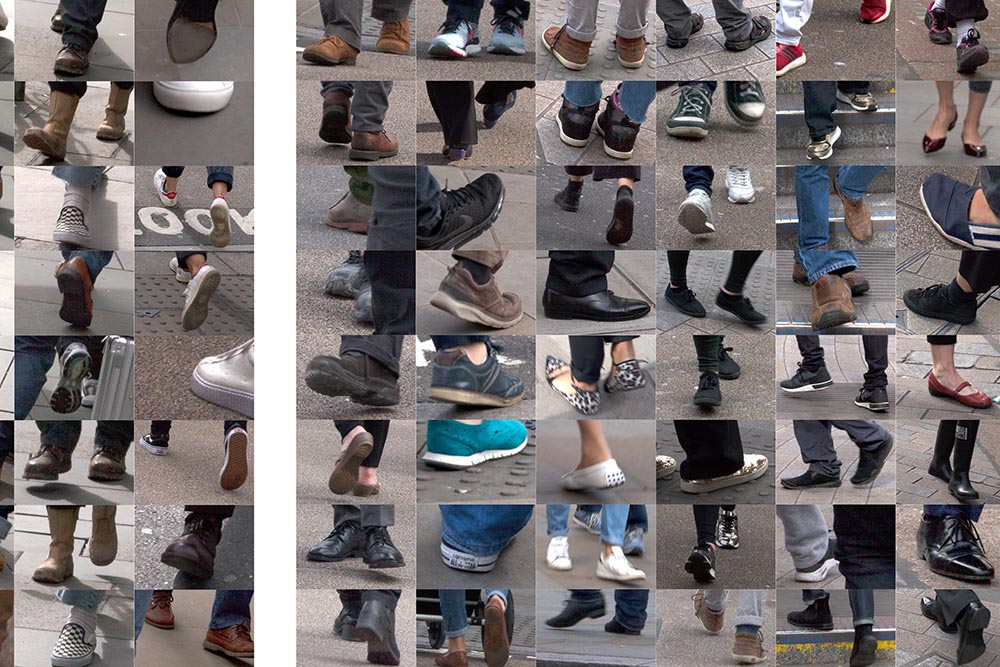
The River's Head, (detail).
2018.
Images and texts by P.F.WHITE (Peter Frankland White). ACTIVE: 196Os to the present. LOCATION: Europe (United Kingdom). SUBJECTS: vision, perception, location, time(s), class, power, rhilopia. STYLE: exploratory, aggregative, aleatory, attentive, punctum averse.
All material (except where otherwise acknowledged) is © Peter Frankland White, , and may not be reproduced in any form without written consent. See: Notes on Rights, Ethics, Privacy and Consent. Page design by Allpicture.